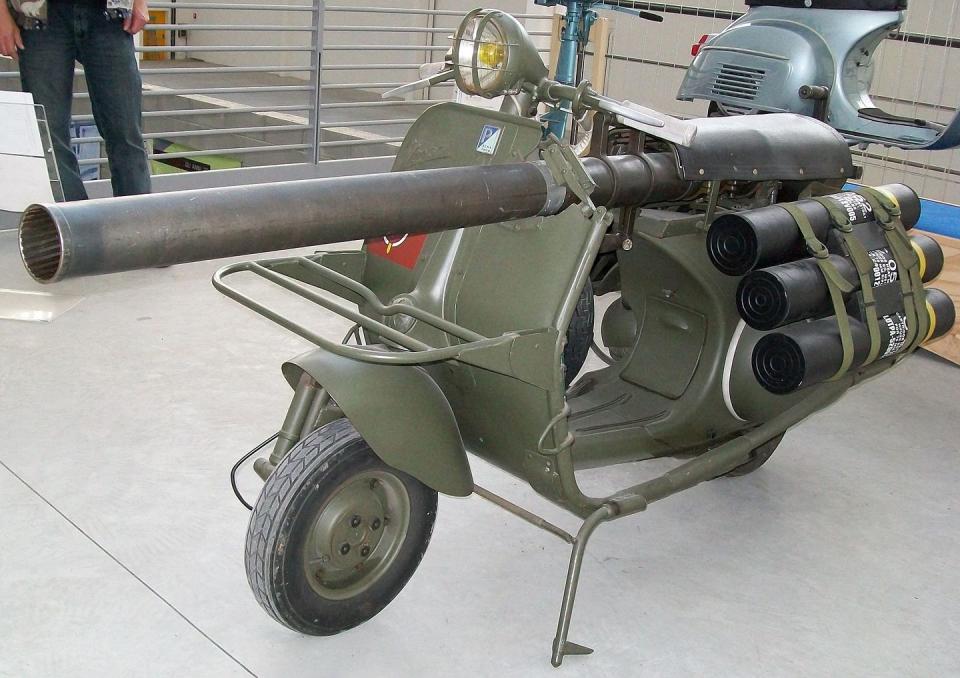Let's Remember When French Paratroopers Once Used Bazooka Vespas in Combat
From forceful fighter jets to tough-as-hell tanks, the world’s militaries often use monster machines to flex their might. But intimidation comes in all sizes. And if we’re going by the most perniciousness per pound, no tech tops the tiny military scooter French paratroopers briefly (and successfully) employed in the 1950s.
➡ You love badass military tech. So do we. Let’s nerd out over this stuff together.
Seeking a modern version of a pack mule that could be dumped out of the back of a cargo aircraft behind enemy lines, France’s post-World War II military equipped its airborne armies with a light, simple, and nimble vehicle that could descend into battle under a parachute.
Absurdly, the Vespa 150 TAP (Troupes Aéroportées; airborne troops) was based on the updated version of the goofy and gutless civilian Italian motor scooter seen in the 1952 movie Roman Holiday. The French vehicle company Ateliers de Construction de Motocycles et Automobiles (ACMA) built the scooters near Dijon from 1956 to 1959, fashioning around 600 for French military forces.
The world’s fightingest motor scooter sported a beefed-up frame and lower gear ratios than the standard models. It bristled with equipment racks for lugging gear and wore a dull olive drab or sand-colored paint scheme in the place of flashy civilian colors like Metallizzato Grigio Azzurro. The bike was powered by a 145.5-cubic-centimeter, single-cylinder, two-stroke motor with a rotary valve design, which allowed a 2 percent oil mixture. Soldiers wryly said the 246-pound machine could attain speeds of about 40 miles per hour … eventually.

The most striking feature of the mini war machine on 8-inch tires, however, was the American-made M20 75-millimeter recoilless rifle under the seat. Giving new meaning to the moniker “crotch rocket,” the burly M20 wasn’t exactly like the bazookas that preceded it. In fact, instead of firing a solid fuel-powered missile, the M20 belched out a 22-pound projectile moving at 1,000 feet per second with the help of a perforated artillery shell casing.
The unique thing about the high-powered weapon is that it was so light. By venting propellant gases out the rear, the 75mm had almost no recoil and no need for a weighty breech block, which meant it could be carried by a soldier—or, in this case, even an Italian motor scooter. The gun could fire smoke, high-explosive, and HEAT anti-tank rounds that were advertised as capable of punching through nearly 4 inches of armor at 7,000 yards.
The pint-sized Vespa looked slightly ridiculous, hefting the big-bore 82-inch long gun that extended from the back fender, under the seat and through a hole in the legshield, to well beyond the front tire.
And what was it like to fire the M20 while on the move? While shooting from the scooter is theoretically possible, there was no way to reliably aim while riding. Instead, France’s airborne troops were more interested in sound tactics and precision gunnery than the pure majesty of perilously setting off the weapon on the open road.

The Vespas dropped into combat from the delivery aircraft in pairs; each strapped to a specialized pallet and standing on a cushion of hay bales to lessen the impact at the end of a parachute descent. For each cannon-carrying scooter, there was a companion bike that was used to carry additional projectiles and a weighty World War I-era tripod.
Some scooters also deployed with an adorable streamlined one-wheeled trolley cart that could be towed behind the bikes. The cart could carry tools, supplies, fuel, and even more ammunition. (Troops behind enemy lines always wanted more ammo.)
Almost immediately ready to roll from the moment of touchdown, the French soldiers would motor to a suitable position and then dismount to set up the gun on the surplus Browning M1917 tripod. The M20 fit on the vintage tripod backward from the way it was oriented when it first shouldered the old water-cooled machine gun during World War I.

Unlike many peculiar military projects undertaken during the Cold War, Vespa 150 TAPs actually made it into combat. French paratroopers in Algeria rode their buzzing military motos into battle lugging their recoilless rifles. While previous conflicts had proven the M20 wouldn’t stop big Soviet-built T-34 tanks in anything but the best conditions, the weapon was well-suited for the Algerian War’s guerilla-style fighting, where paratroopers regularly used the M20s for blasting enemy fortifications and destroying lightly-armored vehicles.
Military brass liked the Vespas because they were relatively inexpensive at just $500 per unit. The firepower would have actually cost more than the bike if there hadn’t been so many surplus US-built M20s available in Europe at the end of World War II.
The front-line riders found the machines dependable, simple to fix, and incredibly mobile, too. While originally built for tooling city streets in Pisa or Florence, the banham Vespas proved they could handle rugged terrain. Years later, four Frenchmen rode Vespas in the Paris to Dakar off-road rally race. Two of them made it the entire distance over roughly 9,000 miles of punishing dunes, rocks, grass, and mud.
Vespa 150 TAPs pioneered the idea of an off-road scooter more than two decades before; in 1950s Africa, there often wasn’t a paved road for miles. Troopers found their trusty scooters, even loaded down, could make headway even under terrible conditions, ranging up to 124 miles on a single tank of gas. And when this unconventional combat vehicle made it to the fighting, it proved that lethal things sometimes come in small packages.
Love Military Machines? Now Watch This:
You Might Also Like


